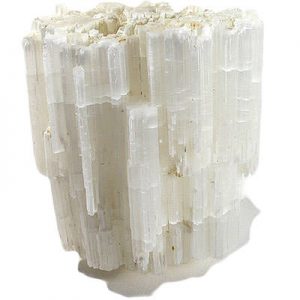Beryllonite
Beryllonite is a rare beryllium mineral and a very rare collector’s gem that was once found only at mines on Sugarloaf Mountain, near Stoneham, Maine, USA. It is now also available from Paprock, Laghman Province, Afghanistan and Linopolis, Minas Gerais, Brazil. It is a difficult gem to cut because of its perfect basal cleavage. Beryllonite gems lack colour, fire and hardness but are very collectable due to their rarity. Beryllonite crystals form in pegmatitic dykes and can easily be confused with more common pegmatite minerals.
Locations for Beryllonite include: in the USA, in Maine, found on Sugarloaf Mountain, near Stoneham, at the Dunton quarry and the Bell Pit, Newry, Oxford County, and other minor occurrences. In Canada, occurs at Mont Saint-Hilaire, Quebec. Found at the Viitaniemi pegmatite, Eräjärvi, Finland. From the Norrö pegmatite, on Rånö Island, Sweden. In England, in the Meldon aplite, Okehampton, Devonshire. Large crystals from Paprock, Laghman Province, Afghanistan. Occurs in the Énio pegmatite mine, northeast of Galiléia; at the Lavra da Ilha pegmatite, in the Jequitinhonha River, three km north of Taquaral; and from the Almerindo mine, Linópolis, Minas Gerais, Brazil.
| Chemical Formula: | NaBe(PO4) |
| Sodium Beryllium Phosphate | |
| Molecular Weight: | 126.97 gm |
| Composition: | Sodium | 18.11 % | Na | 24.41 % | Na2O |
| Beryllium | 7.10 % | Be | 19.70 % | BeO | |
| Phosphorus | 24.39 % | P | 55.90 % | P2O5 | |
| Oxygen | 50.40 % | O | |||
| 100.00 % | 100.00 % | = TOTAL OXIDE |
| Crystallography: | Monoclinic – Prismatic |
| Crystal Habit: | Tabular on {010} to short prismatic || [010]; crystals may have many forms, especially k [100] and [010]; some faces typically etched to dullness, to 25 cm; also in spherical aggregates, fibrous, massive. |
| Twinning: | On {101}, contact and penetration twins; on {110} and {100} polysynthetic and pseudohexagonal stellate twins. |
| Cleavage: | Perfect on {010}, Good but Interrupted on {100}, Indistinct on {101}, in traces on {001} |
| Fracture: | Conchoidal |
| Tenacity: | Brittle |
| Moh’s Hardness: | 5.5 – 6.0 |
| Density: | 7.12 – 7.20 (g/cm3) |
| Luminescence: | None |
| Radioactivity: | Not Radioactive |
| Other: | Fluid inclusions common. Slowly soluble in acids. Alters to Herderite. |
| Color: | Colorless, White, Pale yellow |
| Transparency: | Transparent to Translucent |
| Luster: | Vitreous to Adamantine, may be Pearly |
| Refractive Index: | 1.552 – 1.561 Biaxial ( – ) |
| Birefringence: | 0.0090 |
| Dispersion: | Weak to Distinct; r < v |
| Pleochroism: | None |
| Other: | Fluid inclusions common. |


